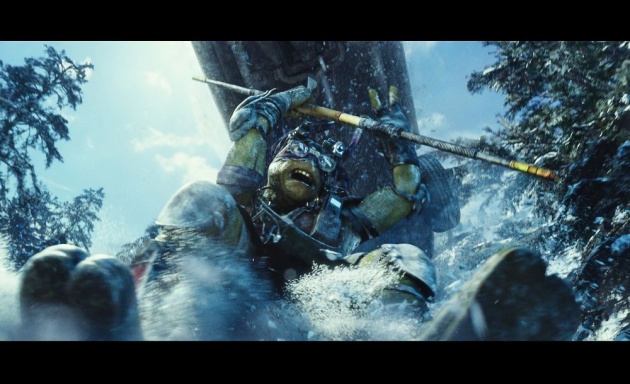
The new version of TEENAGE MUTANT NINJA TURTLES, due for release in the United Kingdom from mid-October, features an unusual credit: snow sequence director, Dan Bradley. The sequence, roughly four-fifths of the way through the movie, is hands down the best piece of action in the movie. In it, the Turtles are racing back towards New York City to prevent an environmental disaster, pursued by assorted anonymous bad guys. This is a cue for some spectacular vehicle manipulation. I didn’t know that there were 532 feet drops somewhere en route to the Big Apple but apparently there are.
The sequence made me think about the other ‘second unit’ directors whose work eclipses the individual with the ‘film by’ credit. Some of these examples are the stuff of movie folk lore – in other words, they have never actually been officially confirmed.
- MAD MAX – BEYOND THUNDERDOME (1986). George Miller shares directing credit for the third movie to feature Max Rocketansky (Mel Gibson), a cop turned Angel of Hope in post-Apocalyptic Australia, with George Ogilvie. Ogilvie did the dramatic stuff and Miller the action. It meant that Miller didn’t have to handle Tina Turner. There could be a reason why the singer did not have a more prolific career in front of the camera. This is definitely the weakest of the original MAD MAX trilogy. We’ll see next year whether Miller has got his mo-jo back in FURY ROAD, which stars Tom Hardy in the Gibson role.
- SIN CITY (2005). Again, this has been officially acknowledged, though Quentin Tarantino’s one piece of ‘guest directing’, of a scene involving Clive Owen and Benicio Del Toro, doesn’t eclipse the work of the official directors, Robert Rodriguez and Frank Miller. Tarantino’s scene is static and dialogue-based (nothing new there) and looks grainier than the rest of the movie. It is noir and pulpy but gives the actors a chance to stretch themselves within the scene rather than just underplay their over-cooked lines.
- THE HUNGER GAMES (2012). One of the darker sequences in Gary Ross’ dystopian ‘young adult’ fantasy was helmed by Steven Soderbergh, who had produced Ross’ earlier film PLEASANTVILLE. Soderbergh is a crisp and clinical director well-suited to sequences that show the power of the authoritarian regime that forces kids to fight each other on behalf of their communities.
- POLTERGEIST (1982). To this day, I refuse to believe that every frame of this was supervised by Tobe Hooper, the director of THE TEXAS CHAINSAW MASSACRE but also the cruddy LIFEFORCE (1985). The scenes between Craig T Nelson and JoBeth Williams as the parents who lose their daughter to television bear the hand of the film’s producer, Steven Spielberg. The film looks as though it was shot around the corner from E.T. – THE EXTRA TERRESTRIAL, in production at the same time. Time to come clean, Mr Spielberg.
- COP OUT (2010). Kevin Smith’s big budget studio cop comedy, which began production with the title, A COUPLE OF DICKS, had a notable contribution from David R. Ellis, who supervised the car chases. According to his account, Smith had a bad time coaxing multiple takes of star Bruce Willis getting out of a car or rushing forward blazing with machine guns, so he had to employ someone else to get the job done. Ellis was responsible for SNAKES ON A PLANE. If he could handle getting Samuel L. Jackson to say that dialogue, handling Willis was a doozy. Ellis passed away in Johannesburg in 2013, aged 60, a fact I discovered when fact-checking this piece.
- STRANGE DAYS (1995). Kathryn Bigalow’s dystopian film noir bore not only a script co-written by her then partner James Cameron but he was also rumoured to help out in the action sequences. Cameron is known for his demanding directorial style (ask the cast of THE ABYSS) – let’s just call it perfectionism. Between Cameron and Bigalow they failed to get a great performance from a post-SCHINDLER’S LIST Ralph Fiennes, who didn’t really deliver on screen again until THE ENGLISH PATIENT (1997).
- A FISH CALLED WANDA (1987). Finally, an example of a film that in production bore the name of a director who never once called action. Charles Crichton, best known for Ealing comedies in the 1950s like THE LAVENDER HILL MOB (1951) could not get insurance to direct John Cleese’s script, so the MONTY PYTHON star volunteered himself as co-director. In the event, Crichton got the job done and Cleese’s farcical heist movie, which featured the ‘dream team’ of Kevin Kline, Jamie Lee Curtis, Michael Palin and himself, was a runaway success – a perfect blend of dark slapstick and comedy of embarrassment, though he did get into trouble for featuring a character with a comical stutter. Cleese’s follow up, FIERCE CREATURES (1997), also had two directors, Robert Young and Australian Fred Schepisi, neither of whom could save an embarrassingly unfunny comedy set in a zoo.



